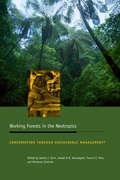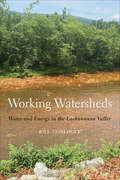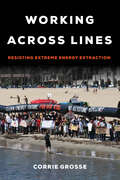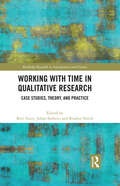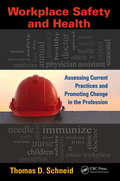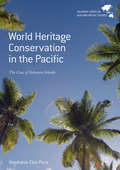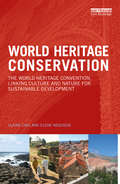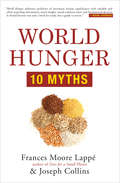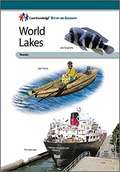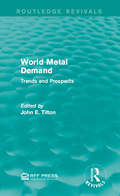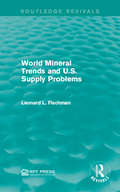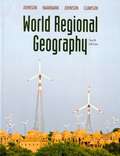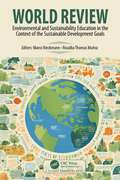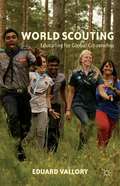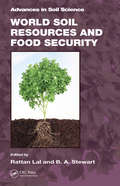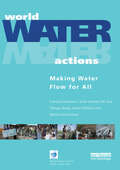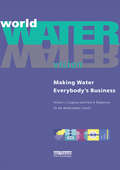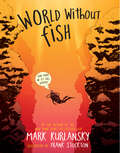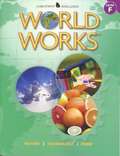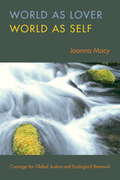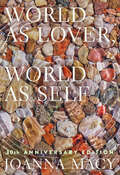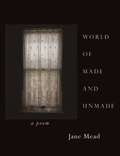- Table View
- List View
Working Childhoods
by Jane DysonWorking Childhoods draws upon research in the Indian Himalayas to provide a theoretically-informed account of children's lives in a remote part of the world. The book shows that children in their pre-teens and teens are lynchpins of the rural economy, spending hours each day herding cattle, collecting leaves, and juggling household tasks with schoolwork. Through documenting in painstaking detail children's stories, songs, friendships, fears and tribulations, the book offers a powerful account of youth agency and young people's rich relationship with the natural world. The 'environment' emerges not only as a crucial economic resource but also as a basis for developing gendered ideas of self. The book should be essential reading for anyone interested in better understanding childhood, youth, the environment, and development within and beyond India - including anthropologists, sociologists, geographers, development studies scholars, and South Asianists.
Working Forests in the Neotropics: Conservation Through Sustainable Management? (Biology and Resource Management Series)
by Daniel J. Janaki R. R. Alavalapati Frances E. Putz Marianne C. Schmink Eds. ZarinNeotropical forests sustain a wealth of biodiversity, provide a wide range of ecosystem services and products, and support the livelihoods of millions of people. But is forest management a viable conservation strategy in the tropics? Supporters of sustainable forest management have promoted it as a solution to problems of both biodiversity protection and economic stagnation. Detractors insist that any conservation strategy short of fully protected status is a waste of resources and that forest management actually hastens deforestation. By focusing on a set of critical issues and case studies, this book explores the territory between these positions, highlighting the major factors that contribute to or detract from the chances of achieving forest conservation through sustainable management.
Working Watersheds: Water and Energy in the Lackawanna Valley
by William ConlogueA personal narrative, an examination of literary texts, and a history of the Lackawanna Valley region, Bill Conlogue’s Working Watersheds explores how water has circulated in the former anthracite capital of the world. Conlogue not only recounts water’s use in anthracite mining and textile making, but also investigates its resulting pollution. He delves into the current natural gas boom, which threatens groundwater, and concludes with hopes of environmental renewal and restoration. Offering a fresh way to think about the Anthropocene, this distinctive history of water and coal in the Lackawanna Valley discusses how both water abundance and scarcity might play out as global temperatures rise. Working Watersheds is designed to trigger debates about the nature of history, the significance of literature, and the importance of linking person, place, and planet in an era of climate change.
Working across Lines: Resisting Extreme Energy Extraction
by Corrie GrosseHow are communities uniting against fracking and tar sands to change our energy future? Working across Lines offers a detailed comparative analysis of climate justice coalitions in California and Idaho—two states with distinct fossil fuel histories, environmental contexts, and political cultures. Drawing on ethnographic evidence from 106 in-depth interviews and three years of participant observation, Corrie Grosse investigates the ways people build effective energy justice coalitions across differences in political views, race and ethnicity, age, and strategic preferences. This book argues for four practices that are critical for movement building: focusing on core values of justice, accountability, and integrity; identifying the roots of injustice; cultivating relationships among activists; and welcoming difference. In focusing on coalitions related to energy and climate justice, Grosse provides important models for bridging divides to reach common goals. These lessons are more relevant than ever.
Working with Time in Qualitative Research: Case Studies, Theory and Practice (Routledge Research in Anticipation and Futures)
by Keri FacerThis volume creates a conversation between researchers who are actively exploring how working with and reflecting upon time and temporality in the research process can generate new accounts and understandings of social and cultural phenomena and bring new ways of knowing and being into existence. The book makes a significant contribution to the enhancement of the social sciences and humanities by charting research methods that link reflectively articulate notions of time to knowledge production in these areas. Contributors explore how researchers are beginning to adopt tactics such as time visibility, hacking time, making time, witnessing temporal power and caring for temporal disruptions as resources for qualitative research. The book collects fields as disparate as futures studies and history, literary analysis and urban design, utopian studies, and science and technology studies, bringing together those who are working with temporality reflexively as a powerful epistemological tool for scholarship and research inquiry. It surfaces and foregrounds the methodological challenges and possibilities raised. In so doing, this collection will serve as a resource for both new and experienced researchers in the humanities and social sciences, seeking to understand the tools that are emerging, both theoretical and methodological, for working with time as part of research design. This book will be of great interest to students and scholars of research methods, time and temporality, future studies, and the environmental humanities.
Workplace Safety and Health: Assessing Current Practices and Promoting Change in the Profession (Occupational Safety & Health Guide Series)
by Thomas D. SchneidAre the tried and true safety practices still effective in the changing workplace? Is there a better way of safeguarding employees from accidents and injuries? In short, why do you perform the safety activities that you do on a daily basis and do they produce the results necessary to keep your safety program and your company competitive in the global market? Answering these questions and more, Workplace Safety and Health: Assessing Current Practices and Promoting Change in the Profession analyzes the current practices and identifies emerging issues and challenges in the safety and health profession.We Need a Game Changer … A New Way of Achieving a Safe and Healthful WorkplaceSafety pioneer and educator Thomas Schneid makes a strong case that mandatory compliance with OSHA regulations is only the first step in a safety program. And that, due to globalization and the current emphasis on sustainability, the requirements of the safety profession have changed. He explores new sources of information and guidance for addressing the new and emerging issues created by the current economic situation, globalization, and the changing workplace. He also identifies and analyzes emerging ethical issues within the safety and health profession, then suggests potential solutions.Schneid then examines the basic assumptions and challenges you to assess and evaluate your activities in search of a better and more effective way of achieving the results necessary to be competitive in today’s workplace. Taking a provocative look at the current issues facing the safety profession, he shows you how to view safety activities and actions from a different perspective and see the real impact they have on the lives of others. He gives you the tools you need to go beyond OSHA compliance and develop safety programs that will be effective in the global workplace and create and maintain a safe workplace that eliminates all injuries and illnesses.
World Heritage Benefits Beyond Borders
by Amareswar GallaPublished on the 40th anniversary of the World Heritage Convention, this thematic collection of case studies provides a thorough understanding of World Heritage sites and their Outstanding Universal Value in the context of sustainable development. The case studies describe twenty six thematically, typologically and regionally diverse World Heritage sites illustrating their benefits to local communities and ecosystems and sharing the lessons learned with the diverse range of stakeholders involved. The volume emphasises a holistic and integrated view of World Heritage, linking it to the role local communities play in management and protection, and to issues of ecosystem sustainability, and the maintenance of biological, linguistic and cultural diversity. Cross-disciplinary in its scope, this book will provide a meeting point for researchers, practitioners, community representatives and the wider public and will promote cultural and natural heritage conservation as a key vector of sustainable development and social cohesion.
World Heritage Conservation in the Pacific: The Case of Solomon Islands (Palgrave Series in Asia and Pacific Studies)
by Stephanie Clair PriceThis book explores the opportunities and challenges associated with the legal protection of World Heritage sites in the Pacific Islands. It argues that the small Pacific representation on the World Heritage List is in part due to a lack of strong legal frameworks for heritage conservation, putting such sites under threat. Providing a comprehensive analysis of the nomination, listing and protection of the Solomon Island World Heritage Site, it examines the implementation of the World Heritage Convention in the Pacific context. It explores how the international community’s broadening interpretation of the notion of ‘outstanding universal value’ has increased the potential for Pacific heritage to be classified as ‘World Heritage’. This book also analyses the protection regime established by the Convention, and the World Heritage Committee’s approach to heritage conservation, identifying challenges associated with the protection of Pacific Island heritage.
World Heritage Conservation: The World Heritage Convention, Linking Culture and Nature for Sustainable Development
by Claire Cave Elene NegussieThe UNESCO World Heritage Convention has become one of the most successful UN instruments for promoting cultural diplomacy and dialogue on conservation of cultural and natural heritage. This book provides an overview of the convention through an interdisciplinary approach to conservation. It shows that based on the notion of outstanding universal value and international cooperation for the protection of heritage, the convention provides a platform for sustainable development through the conservation and management of heritage of significance to humanity. With increasing globalization of heritage, World Heritage Conservation is reviewed as an emerging interdisciplinary field of study creating new opportunities for inclusive heritage debate both locally and globally, requiring common tools and understanding. With over a thousand properties inscribed on the World Heritage List, from biologically diverse sites such as the Central Amazon Conservation Complex to the urban landscape of the metropolis of Rio de Janeiro, the book will help students, researchers and professionals in the identification, protection, conservation and presentation of World Heritage. Targeted at a diversity of disciplines, the book critically describes the strategies for implementing the convention and the processes of heritage governance for sustainable development.
World Hunger: 10 Myths
by Joseph Collins Frances Moore LappéFrom bestselling authors Frances Moore Lappé and Joseph Collins comes the 21st century’s definitive book on world hunger. Driven by the question, "Why hunger despite an abundance of food?" Lappé and Collins refute the myths that prevent us from addressing the root causes of hunger across the globe. World Hunger: Ten Myths draws on extensive new research to offer fresh, often startling, insights about tough questions-from climate change and population growth to genetically modified organisms (GMOs) and the role of U.S. foreign aid, and more.Brimming with little-known but life-changing examples of solutions to hunger worldwide, this myth-busting book argues that sustainable agriculture can feed the world, that we can end nutritional deprivation affecting one-quarter of the world’s people, and that most in the Global North have more in common with hungry people than they thought. For novices and scholars alike, World Hunger: Ten Myths will inspire a whole new generation of hunger-fighters.
World Lakes (Core Knowledge History and Geography)
by Core Knowledge FoundationWORLD LAKES begins with a review of map skills and geographical terms. Students learn about the benefits and resources provided by lakes, including, in Asia, the Caspian and Aral Seas; in Africa, Lakes Victoria, Tanganyika, and Chad; in South America, Lakes Maracaibo and Titicaca; and, in North America, Lakes Superior, Huron, Michigan, Erie, and Ontario.
World Metal Demand: Trends and Prospects (Routledge Revivals)
by John E. TiltonIn the early 1970s, the post-World War II boom in world metal consumption came to a halt. As time passed, it became clear that what many first thought to be a cyclical downturn was instead a long-term, substantial decline in world metal demand. In this volume, first published in 1990, editor John E. Tilton and four fellow scholars of mineral economics analyse the causes and consequences of this decline and the prospects for future growth in world metal demand. This book will be of interest to students of business and environmental studies.
World Mineral Trends and U.S. Supply Problems (Routledge Revivals)
by Leonard L. FischmanEven though the United States relies heavily on imports for many non-fuel minerals, mineral supply has played only a small role in foreign policy since World War II. Originally published in 1980, this report investigates seven major non-fuel minerals in relation to long-term potential supply and price problems and any short-term issues that may arise to put concerns about supply in perspective for policy-makers. This title will be of interest to students of Environmental Studies and professionals.
World Regional Geography (10th edition)
by David L. Clawson Merrill L. Johnson Douglas L. Johnson Viola HaarmannPulling from an impressive team of ten authors, each chapter in this book has been authored by an expert in the region to provide the utmost accuracy and relevancy. World Regional Geography explores the character of the world's people, with a central theme of human development, for an issues-oriented overview of each region. An emphasis on subregions (places within regions) enables readers to explore specific locales. An economic development theme offers a more conceptual treatment than the traditional coverage of this topic. Basic Concepts and Ideas; The United States and Canada; Latin America and the Caribbean; Europe; Northern Eurasia; Central Asia and Afghanistan; The Middle East and North Africa; Africa South of the Sahara; South Asia; East Asia; Southeast Asia; Australia, New Zealand, and the Pacific Islands. The useful references for anyone who wants to learn more about the different regions of the world.
World Review: Environmental and Sustainability Education in the Context of the Sustainable Development Goals
by Marco Rieckmann Rosalba Thomas MuñozThe global landscape of education has been reshaped by the COVID-19 pandemic, revealing the various challenges faced by countries worldwide. This book provides a comprehensive exploration of Environmental and Sustainability Education (ESE) across different countries, offering unique insights into their histories, challenges, achievements, and future ESE needs. From Africa to Oceania, the book delves into the vital role of ESE in the context of the UN Sustainable Development Goals. It highlights the diverse national discourses and the flexibility required to deliver effective global education programs. ESE practitioners, researchers, and policymakers worldwide will find inspiration and invaluable perspectives in this book.
World Scouting
by Eduard ValloryThis is the very first book to look at scouting worldwide and explain in a comprehensible way the largest youth movement on the planet, with a presence in over 165 countries on 5 continents. Based on the first academic research on world scouting, it covers the history of boy and girl scouting from its origins to the present, its structure and recognition policy, and its role in developing ideas of global citizenship and belonging. Using new data and storytelling, Eduard Vallory discusses the main elements that distinguish the scout movement all over the world; explains its origin, evolution, operating system, and values; and deals with its controversies.
World Soil Resources and Food Security (Advances in Soil Science)
by Rattan Lal B. A. StewartSoil-The Basis of All Terrestrial LifeAncient civilizations and cultures-Mayan, Aztec, Mesopotamian, Indus, and Yangtze-were built on good soils, surviving only as long as soils had the capacity to support them. In the twenty-first century, productive soil is still the engine of economic development and essential to human well-being. The quality of
World Water Actions: Making Water Flow for All
by Francois GuerquinThis text is divided into three parts. Part I focuses on the need for management to assess the challenges of water scarcity and plan changes based on proper valuation and financial instruments, international co-operation and efficient use. Part II analyses the problems of water scarcity and the available solutions in each main sector: water supply and sanitation, energy, health, agriculture, ecosystems and biodiversity. Part III assesses the state of the debate following the third World Water Forum and sets out the priorities for action, including increased investment, institutional reform and capacity building in the water sector. Downloadable resources with extensive case studies and statistical data accompanies this text.
World Water Vision: Making Water Everybody's Business
by William J. Cosgrove Frank R. RijsbermanMore than a billion people cannot get safe drinking water; half the world's population does not have adequate sanitation; within a generation over three billion will be suffering from water stress. This text analyzes the issues in this crisis of management and shows how water can be used effectively and productively. The key to sustainable water resources is an integrated approach. The authors assert that careful planning and concerted action can make the fundamental changes needed and that the implications of not dealing with the crisis are immense. The book comes with a CD ROM containing background research and scenarios.
World Without Fish
by Frank Stockton Mark Kurlansky"Can you imagine a world without fish? It's not as crazy as it sounds. But if we keep doing things the way we've been doing things, fish could become extinct within fifty years. So let's change the way we do things!" Announcing the paperback edition of World Without Fish, the uniquely illustrated narrative nonfiction account—for kids—of what is happening to the world’s oceans and what they can do about it. Written by Mark Kurlansky, the bestselling author of Cod, Salt, The Big Oyster, and many other books, World Without Fish has been praised as “urgent” (Publishers Weekly) and “a wonderfully fast-paced and engaging primer on the key questions surrounding fish and the sea” (Paul Greenberg, author of Four Fish).?It has also been included in the New York State Expeditionary Learning English Language Arts Curriculum. Written by a master storyteller, World Without Fish connects all the dots—biology, economics, evolution, politics, climate, history, culture, food, and nutrition—in a way that kids can really understand. It describes how the fish we most commonly eat, including tuna, salmon, cod, swordfish—even anchovies— could disappear within fifty years, and the domino effect it would have: the oceans teeming with jellyfish and turning pinkish orange from algal blooms, the seabirds disappearing, then reptiles, then mammals. It describes the back-and-forth dynamic of fishermen, who are the original environmentalists, and scientists, who not that long ago considered fish an endless resource. It explains why fish farming is not the answer—and why sustainable fishing is, and how to help return the oceans to their natural ecological balance. Interwoven with the book is a twelve-page full-color graphic novel. Each beautifully illustrated chapter opener links to the next to form a larger fictional story that perfectly complements the text.
World Works, Level F: Nature, Technology, Food
by McGraw-HillExplore how things work through high-interest, engaging informational nonfiction!Improve reading comprehension of informational nonfiction, encourage student inquiry with high-interest topics, and prepare students for high-stakes assessments with the World WorksTM series from Jamestown Education. World WorksTM brings the world to life. Each four-color, consumable book of the 6-book series features 9 informational articles focused on how things work. Each unit within a book covers one of the following topics; Everyday Things, Law, Health, Food, Technology, or Nature. All categories are covered at each reading level. Each article answers the question, "How Does it Work?" Each informational article includes a graph, chart, or diagram, along with an after-reading critical-thinking questions on interpreting charts and graphs.
World as Lover, World as Self
by Joanna MacyA new beginning for the environment must start with a new spiritual outlook. In this book, author Joanna Macy offers concrete suggestions for just that, showing how each of us can change the attitudes that continue to threaten our environment. Using the Buddha's teachings on Paticca Samuppada, which stresses the interconnectedness of all things in the world and suggests that any one action affects all things, Macy describes how decades of ignoring this principle has resulted in a self-centeredness that has devastated the environment. Humans, Macy implores, must acknowledge and understand their connectedness to their world and begin to move toward a more focused effort to save it.
World as Lover, World as Self: A Guide to Living Fully in Turbulent times
by Joanna MacyThis overview of Joanna Macy's innovative work combines deep ecology, general systems theory, and the Buddha's teachings on interdependent co-arising. A blueprint for social change, World as Lover, World as Self shows how we can reverse the destructive attitudes that threaten our world, with concrete suggestions on how to address "An Inconvenient Truth".The essays are based on the Buddha's teachings of "Paticca samuppada" (interdependent co-arising). Reduced to deceptively simple terms this says that everything in the world- every object, feeling, emotion, and action is influenced by a huge, all-inclusive web of factors. Any change in the condition of any one thing in this web affects everything else by virtue of interconnectedness. It makes World as Lover World as Self a quintessential guide for those readers who want to integrate their Buddhist practice with concerns for social issues like global warming. It also breaches the dualities that have haunted much of both Eastern and Western thought, namely the dichotomies between mind/body, humanity/nature, reason/emotion, self/world, science/spirituality.The premise is that self-centeredness, and modern individualisms are ultimately destructive for the environment. We are not individuals separate from the world. Instead we are always "co-arising" or co-creating the world, and we cannot escape the consequence of what we do to the environment. Joanna Macy presents a re-focusing on the beauty of the natural world as personally nourishing and replenishment as one way to move away from our self-centeredness. For this revised edition the author will be adding some chapters as well as removing others. The new ones will deal largely with her new work around the "Great Turning" that will add a somewhat more visionary, future-oriented, and strategic dimension to the book. World as Lover, World as Self shows us how to realize that the earth is an extension of ourselves and how to discover the knowledge, authority and courage to respond creatively to the crises of our time. Foreword Thich Nhat Hanh
World as Lover, World as Self: Courage for Global Justice and Planetary Renewal
by Joanna MacyThis overview of Joanna Macy's innovative work combines deep ecology, general systems theory, and the Buddha's teachings on interdependent co-arising. A blueprint for social change, World as Lover, World as Self shows how we can reverse the destructive attitudes that threaten our world, with concrete suggestions on how to address "An Inconvenient Truth".The essays are based on the Buddha's teachings of "Paticca samuppada" (interdependent co-arising). Reduced to deceptively simple terms this says that everything in the world- every object, feeling, emotion, and action is influenced by a huge, all-inclusive web of factors. Any change in the condition of any one thing in this web affects everything else by virtue of interconnectedness. It makes World as Lover World as Self a quintessential guide for those readers who want to integrate their Buddhist practice with concerns for social issues like global warming. It also breaches the dualities that have haunted much of both Eastern and Western thought, namely the dichotomies between mind/body, humanity/nature, reason/emotion, self/world, science/spirituality.The premise is that self-centeredness, and modern individualisms are ultimately destructive for the environment. We are not individuals separate from the world. Instead we are always "co-arising" or co-creating the world, and we cannot escape the consequence of what we do to the environment. Joanna Macy presents a re-focusing on the beauty of the natural world as personally nourishing and replenishment as one way to move away from our self-centeredness. For this revised edition the author will be adding some chapters as well as removing others. The new ones will deal largely with her new work around the "Great Turning" that will add a somewhat more visionary, future-oriented, and strategic dimension to the book. World as Lover, World as Self shows us how to realize that the earth is an extension of ourselves and how to discover the knowledge, authority and courage to respond creatively to the crises of our time. Foreword Thich Nhat Hanh
World of Made and Unmade
by Jane MeadMead's fifth collection candidly and openly explores the long process that is death. These resonant poems discover what it means to live, die, and come home again. We're drawn in by sorrow and grief, but also the joys of celebrating a long life and how simple it is to find laughter and light in the quietest and darkest of moments.

